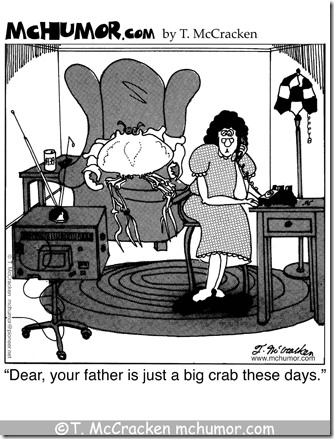sausage
Should we be depressed watching this draft seeing very limited Michigan players taken? I mean I know we haven't been a good football team lately, but I look at a guy like Donavan Warren. Couldn't SOMEBODY have told him he wasn't ready for the pros? Unless I'm way wrong and he is ready? I just wanted to get your thoughts on when it makes sense for a junior to declare early. It seems to me that if you aren't a lock in the first 3 rounds, it's just not worth it. I could be wrong on this, that's why I'm asking your opinion on it.
Thanks man,
Chris
Chris: if you are surveying the recent history of Michigan football and deciding that this year's NFL draft is the reason to be depressed, you are the modern day equivalent of one of those guys on the cross singing "Always Look on the Bright Side of Life."
As far as Warren goes, I touched on it briefly when Mark Carrier went to the well and declared the Michigan Warren signed up for "wasn't there anymore," but to expand on it: there were a lot of different factors that went into Warren's unwise decision to declare. Conventional wisdom held that Warren was looking at three years and out from the moment he stepped on campus. All the coaches he signed up to play for were broomed. Then he got a mid-round-at-worst grade from the NFL Advisory Committee—basically a "lock for the first three rounds." His decision was an expected outcome. The unexpected bit was not getting drafted.
FWIW, when all this was going down I did get the impression that Rodriguez thought Warren was not ready for the pros:
Michigan coach Rich Rodriguez said in a radio interview Monday he wishes cornerback Donovan Warren would have got more information before declaring for the NFL draft.
"I probably would have preferred to wait until I get the NFL advisory committee information back, which I have not gotten back yet," Rodriguez said on WDFN 1130-AM. "I don’t know if he talked to enough people yet or not, but he feels he has. I kind of wish he got a little bit more information so he would have been sure before he made his declaration."
He took off anyway. It happens from time to time—remember Shantee Orr?—but less frequently when you haven been placed in a situation someone else chose for you.
Brian,
I had a discussion w/ Jon Chait about the 2 QB system. I personally feel that it is a bad idea but I don't necessarily always agree with the platitudes spun on ESPN ("if you have 2 QBs it means you have none"). Is there any evidence of a 2 QB system really being bad? Jon brought up the Leak/Tebow duo and the 1982 Miami Dolphins. Certainly 2 teams in 25 years is not much of a success rate but I was hoping you or Mathelete might have some more detailed data.
Thanks,
Dan Rontal
I could probably dig up some evidence that two QB systems are less effective than your average one QB system but that's a lot of effort to state something logically obvious: the chances of having one excellent quarterback are low. The chances of having two are vanishingly small. Therefore, playing two quarterbacks means you do not have an excellent quarterback. QED.
HOWEVA, this assumes that quarterback excellence comes in one shape, something that was 100% true for the duration of the Carr regime. The shape was a 6'5" fixed artillery piece 50% as white as We Are ND.
that's really, really white
When Carr experimented with his Henson-Brady platoon, that was something he'd promised Henson to prevent him from signing an enormous baseball contract. Even that petered out as Michigan began to realize what it had in Tom Brady. They were running the same stuff with both, so it made no sense to go with the guy who wasn't a crazy accurate cold-blooded senior.
The situation in 2010 is a lot closer to Leak/Tebow (minus the hellacious defense) than Brady/Henson. Michigan's two quarterbacks are radically different players. In that case it makes sense to use them in different situations. On third and one, Denard is a better option. On third and fifteen, Tate is. On first and ten it will depend on who the opponent is and how the quarterbacks are playing that day.
I have a feeling that by midseason it will be clear one or the other is the starter, but I also think both QBs will see snaps in every game this year.
Hi Brian-
I was wondering if you could help me understand something. How does this deal between ESPN and SEC affect the amount of Big 10 games that are televised on ABC/ESPN/ESPN2? In terms of football, is the SEC really getting that much more coverage on ESPN compared to the Big 10 on Saturdays (the Big 10 doesn't really play games any other day of the week too often)?
Up until now, I have been able to watch tons of Big 10 games on these channels (I live in Boston), but now I am afraid that they are going to be playing more SEC games and I will only get the 1 game at a time I get on the Big 10 Network. Everything I read makes it sound like ESPN bought the broadcasting rights to all these SEC football games and other athletic events and that they will be dominating the ESPN airwaves, but if it started last fall (2009), I sure didn't notice a difference because they still played pretty much every Big 10 game not on the Big 10 Network (Indiana vs. Minnesota aside).
Any ways, just wondering if you have any insight on this.
Thanks,
Brian
The SEC deal has no impact on the Big Ten/ABC contract. ABC always gets first choice of Big Ten games every weekend, then ESPN, ESPN 2, and the BTN have a complicated system in which they alternate the second pick. The BTN gets two or three opportunities to go second—which is how they scooped up the M-MSU game in year two of the network, causing mass panic at the prospect it might not be on television in the state.
In fact, the much-hyped SEC deal is now coming in for local criticism because MLS and women's basketball have more pull than SEC gymnastics. The net effect has been to move the crappy SEC games from Raycom syndication (the ironically beloved "three Daves" setup) to the obscurer reaches of the ESPN dial (U and Classic). Since Big Ten games were never played on those networks, the impact on the conference is nil. I don't think the SEC pact actually does much of anything for the league other than fill their pockets: ESPN isn't going to stop televising good Pac 10/ACC/Big 12 games.
The Big Ten's ABC/ESPN deal is even better than the SEC deal in one critical respect: it mandates that any regional broadcast is "reverse mirrored" on another channel. End result:
The Boilermakers appeared on National or National/Regional Television for every game (12) [ed: thanks for the game count protip, marketing droid!] during the 2009 season. Boiler Up!
11:20 AM May 5th via web
That's really cool for Purdue. It is also true for every Big Ten team, even Indiana. There is no such thing as a Big Ten football game you cannot get nationally. The genius of the Big Ten network is matched by the genius of the reverse mirror. Whoever got that inserted into the Big Ten TV contract earns his keep.
BONUS: how huge is the ESPN/SEC contract going to look in 15 years? Not very huge. The Big Ten is already matching or exceeding it and their deal with FOX includes profit-sharing that has already kicked in. When not speaking publicly, Jim Delany is a ninja.
Brian,It seems to me that if we are going to poach from the Big 12 -- it makes the most sense to make a play for Texas as taking 2 teams from the conference makes its demise all but certain and could push Texas into the SEC or Pac-10.If we are going to be Machiavellian a la Notre Dame, it makes no sense to pursue two decent Big 12 schools when doing so pushes the crown jewel (athletically, academically, and demographically) into a rival camp. Thoughts?Relatedly, what is the basis for the comments that the TX legislature would only permit that if the Big 10 took A&M too?Thanks for humoring me.-Name Withheld
Daddy, would you like some sausages?
I don't know what the basis for the TX legislature road block meme is Austin seem like the active sort and I buy it. Besides, A&M is a fine school in its own right.
Anyway: I'm with you. It's been universally agreed that Texas is the biggest fish in the pond. The problem with Texas is that it's geographically isolated from the Big Ten and beholden to a state legislature that somehow finagled perpetually useless Baylor into the Big 12. They've got power and they're nosy enough to use it.
But if this 16-team Big Ten is actually going to transpire, is that relevant? If the Big Ten grabs five teams they can lop off Missouri, Nebraska, Texas, Texas A&M, and Oklahoma in one enormous western surge. Big Ten Manifest Destiny seriously reduces the geographic implausibility and provides the Big Ten the most sheer intimidation possible. If we're putting the Big Cthulhu on the table, I don't see why the Big East has to be involved at all, or Notre Dame for that matter. It makes more sense to dismember one conference in its entirety.
I know that Oklahoma's academic standing has been widely declared a nonstarter for the Big Ten's ivory tower types. If that's the case, grabbing Colorado or Kansas has almost the same effect—Texas tentacles—with considerably less chewing tobacco at conference meetings.
Brian,
Exactly what happens between now and August? I really mean EXACTLY, not just "they do some conditioning and stuff". Someone out there (football coaches or maybe former players) must know the answer.
Thank you,
Marc 71
I can't give you an all-caps EXACT answer, but I did ping Tyler Sellhorn for a moderately detailed one. Without further ado:
Dear Brian,
While school is still in session, the program can require attendance at conditioning. When school lets out the players voluntarily submit themselves to The Church of Barwis, take 4-6 credit hours of summer school (so that most players, i.e. general studies majors, can take a minimum full-time courseload during the year and still be on track to graduate), most student-athletes will spend a week at home, and then Fall camp starts in August. Also, the quarterbacks and defensive leaders are usually encouraged to organize skeleton passing sessions as well, but as we know too well now, coaches are not permitted to even witness said seven-on-seven sessions.
That is not an exactly, but a general overview that should answer less curious minds than Marc71.
God Bless,
Tyler Sellhorn
Thanks to Mr. Sellhorn.
When you do a Google image search for "sixteen" you get two types of results: the literally porny and the metaphorically porny. We're going with metaphorically. This is a wikipedia commons image used in the articles on "sausage" and "gluten-free diet."
So… yeah. As mentioned in Friday's UV, the big expansion news was exactly nothing and we can all resume our lives without feverishly plotting complicated ways to make a 16 teams have a meaningful championship with only 8-10 games at their disposal. Unfortunately for many, many people this comes too late.
First: Brian Fremeau points out that current NCAA bylaws demand you have at least twelve teams to stage a championship game. They also require that there are two divisions in which everyone plays each other and that the champions of those divisions play in the game. If we're blowing the world up here you can probably get this to change, but that's a hurdle for the more elaborate proposals.
 Skeptics
Skeptics
Many people complained that anything other than something boring and unbalanced would never happen. Skepticism noted. Now please return to your crabholes and have crabfights with the crabwife. You are crabby.
(@ Right: the funniest thing that has ever been put on paper. Do you see what T. McCracken did there? I do. I do so hard.)
Pod People
As The Only Colors puts it:
With 16 teams, I think you have to go with something like this--basically playing a multi-round playoff, but hiding the first couple rounds in the regular season. But I also hate to lose the familiarity of playing major rivals every year and being guaranteed to play everyone in the conference at least once every few years.
A lot of people suggested organizing the Big Ten into pods of four. Instead of two static eight-team divisions there are four four-team pods. Each year a pod is paired with a different pod, so instead of playing seven teams every year and eight teams very infrequently you play three teams every year and twelve once every three years. This is similar to what the WAC did when it was a 16-team monstrosity.
So keep the pods in the back of your mind as you ponder…
In-Season Playoffs
I came to the conclusion that the most feasible way to have a meaningful conference schedule was to play all your divisional games first and then have dynamically allocated crossover games against teams about as good as you. This appears to be a common solution, but most other people used the leftover games to stage an in-season playoff.
In-season Semifinals
TOC's proposal is similar to the Totally Bats Proposal with the following exceptions:
- Four team rotating pods.
- There's one bonus game where the #1 in division 1 plays the #2 in division 2 and vice versa, followed by a championship game.
Feasibility: Leaving aside TOC's ludicrous divisions, which cleave Michigan from Ohio State and Wisconsin from their triangle of hate with Minnesota and Iowa? About as good as BTWC. Maybe better since there only 8 conference games still, but if the BIg Ten really goes to 16 they almost have to add a ninth conference game; at that point I'd be in favor of a tenth, bowl eligibility be damned.
Efficacy: I like mine better because it's a better intersection of the top teams.
Fun factor: Not crazy enough for me.
In-season Semifinals With Pod Divisions
Maize 'n' Brew proposes four team-pods like TOC. Conference schedules are a round robin in your pod and five games against other opponents that are "selected by committee." That's a little odd. I imagine they'd put in a rotation of some sort. The winner of each pod heads to a semifinal game. The remaining teams play another conference game.
Feasibility: would require major change to bylaws to pass. Otherwise similar to other in-season playoff proposals.
Efficacy: eh… too much randomness in your opponents for my tastes
Fun factor: About the same.
In-season Eight(!) Team playoff
MGoUser U of M in Tx proposes what's essentially an eight-team playoff with the top four in each division making it. Seeds are not exact because he attempts to even up the home games and priority is placed on avoiding rematches if possible. Since everyone keeps playing, there are still nine conference games for everyone. He also proposes the bottom eight have a similar tournament with some special bowl bid on the line; that adds a second championship-ish game on the same weekend as the actual championship.
There's another version of this from Tacopants that has four-team pods with two protected rivalry games outside of the pods, two more crossover games, and the eight-team in-season playoff. It does not use divisions.
Feasibility: worse than the backwards group because it requires the NCAA to approve a second championship-type game. Does violate the bylaw because two teams from the same division could make it to the final.
Efficacy: Eight team playoff ranks highly here. Playoffs make more sense as you add teams and remove games.
Fun factor: Good. Quasi-championship game would be kind of fun, if not that important.
Totally Impractical Stuff
And if I think it's impractical, everyone else does.
maddogcody suggests a divisional format where the last week of every season is a game against your counterpart in the other division at a neutral site that is another home stadium in the Big Ten. That's a really weird way to force everyone to travel an a guarantee of many empty seats.
The Mathlete suggests a wholesale reimagining of the BCS conferences that ends with five separate 15-team conferences that play an eight-team playoff at the end of the year. Individual conferences are broken down into five-team divisions that play each other and two or three opponents in the other divisions. Division champions plus one wild card make conference playoffs. This one requires 17 games for national championship game participants and for five different conferences to do the same thing. Too many cats to herd.
Boston College blog BC Interruption chips in with a question:
Why Stop At 16?
This is one of those questions where if they don't know, you can't tell 'em. BCI absorbs the entire Big East plus Notre Dame to create a 20-team league that operates as two separate Pac-10s. Michigan gets chucked in a division with UConn, Syracuse, Rutgers, WVU, Cincinnati, Pitt, Penn State, Michigan State, and Ohio State, never to play for the Little Brown Jug again. For a thousand reasons from "Cincinnati and Louisville in the CIC" to "gaaah," this thing is never getting off the ground.
Priorities and Conclusions
Any conference that bloats to 16 teams is going to have problems determining a real champion without resorting to some oddities. A plain old divisions-plus-random-crossover-games setup is going to make the other division feel alien and introduce scheduling quirks that promise to have a distorting effect on the conference title race. Virtually all solutions propose taking information from early in the season and applying it to the last couple weeks of the season so that good teams play each other, whether it's in the form of a playoff in all but name or a crazy World Cup group or divisions-plus-nonrandom-crossover-games. That seems like the only way to make a 16-team football conference functional.
And now I will stop talking about this for at least three months, promise.



32